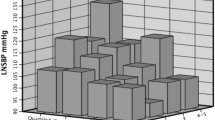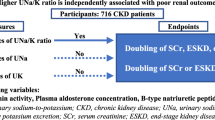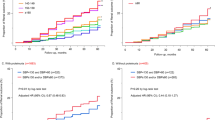Abstract
Moderately increased albuminuria, defined as urinary albumin excretion rate (UAER) between 30 and 300–mg/24–h is a well-known cardiovascular risk factor, especially in diabetic and hypertensive patients. This study aim to analyze the prognostic value of baseline UAER in a still understudied group, patients with resistant hypertension (RHT). This is a prospective observational study, which had enrolled 1048 outpatients with RHT, who were submitted to a clinical-laboratory assessment and ambulatory blood pressure monitoring (ABPM) during the follow-up. Primary endpoints were a composite of fatal and non-fatal cardiovascular events, all-cause mortality and cardiovascular mortality. Survival analysis by multiple Cox regression assessed the associations among endpoints, baseline UAER, glomerular filtration rate (GFR), and ABPM control. After a mean 7.5 years follow-up, 233 patients died, 120 from cardiac death; 215 cardiovascular events occurred, 90 strokes and 116 coronary diseases. UAER above 30–mg/24–h increased above 40% the risk of fatal and non-fatal cardiovascular events, and of all-cause mortality. At these UAER levels, secondary outcomes were associated to increased risk of stroke and risk of end-stage renal disease, but did not affect coronary events. Both the GFR below 60–mL/min and uncontrolled ABPM were related to nearly two-fold raised risk of fatal and non-fatal cardiovascular events, when coupled with UAER above 30–mg/24–h. In conclusion, moderately increased albuminuria predicts cardiovascular events and all-cause mortality in RHT, and its prognostic impact is enhanced in association with a GFR under 60–mL/min and uncontrolled baseline ABPM.
This is a preview of subscription content, access via your institution
Access options
Subscribe to this journal
Receive 12 digital issues and online access to articles
$119.00 per year
only $9.92 per issue
Buy this article
- Purchase on Springer Link
- Instant access to full article PDF
Prices may be subject to local taxes which are calculated during checkout



Similar content being viewed by others
References
Mancia G, Fagard R, Narkiewicz K, Redón J, Zanchetti A, Böhm M, et al. ESH/ESC guidelines for the management of arterial hypertension: the Task Force for the management of arterial hypertension of the European Society of Hypertension (ESH) and of the European Society of Cardiology (ESC). J Hypertens. 2013;2013:1281–357
Özyilmaz A, de Jong PE, Bakker SJL, Visser ST, Thio C, Gansevoort RT, PREVEND Study Group. Screening for elevated albuminuria and subsequently hypertension identifies subjects in which treatment may be warranted to prevent renal function decline. Nephrol Dial Transplant 2017;32:ii200–8.
Cerasola G, Cottone S, Mule G. The progressive pathway of microalbuminuria: from early marker of renal damage to strong cardiovascular risk predictor. J Hypertens 2010;28:2357–69.
Parving HH, Persson F, Rossing P. Microalbuminuria: a parameter that has changed diabetes care. Diabetes Res Clin Pract 2015;107:1–8.
Leoncini G, Viazzi F, Pontremoli R. Chronic kidney disease and albuminuria in arterial hypertension. Curr Hypertens Rep 2010;12:335–41.
Cao JJ, Biggs ML, Barzilay J, Konen J, Psaty BM, Kuller L, et al. Cardiovascular and mortality risk prediction and stratification using urinary albumin excretion in older adults ages 68–102: the Cardiovascular Health Study. Atherosclerosis 2008;197:806–13.
Yuyun MF, Khaw K-T, Luben R, Welch A, Bingham S, Day NE, et al. A prospective study of microalbuminuria and incident coronary heart disease and its prognostic significance in a British population: the EPIC-Norfolk study. Am J Epidemiol 2004;159:284–93.
Calhoun DA, Jones D, Textor S, Goff DC, Murphy TP, Toto RD, et al. Resistant hypertension: diagnosis, evaluation, and treatment. A scientific statement from the American Heart Association Professional Education Committee of the Council for High Blood Pressure Research. Hypertension 2008;51:1403–19.
Judd E, Calhoun DA. Apparent and true resistant hypertension: definition, prevalence and outcomes. J Hum Hypertens 2014;28:463–8.
Daugherty SL, Powers JD, Magid DJ, Tavel HM, Masoudi FA, Margolis KL, et al. Incidence and prognosis of resistant hypertension in hypertensive patients clinical perspective. Circulation 2012;125:1635–42.
de Souza F, Muxfeldt ES, Salles GF. Prognostic factors in resistant hypertension: implications for cardiovascular risk stratification and therapeutic management. Expert Rev Cardiovasc Ther. 2012;10:735–45.
Romero CA, Peixoto AJ, Orias M. Estimated GFR or albuminuria: which one is really associated with resistant hypertension? Semin Nephrol 2014;34:492–7.
Salles GF, Cardoso CRL, Fiszman R, Muxfeldt ES. Prognostic importance of baseline and serial changes in microalbuminuria in patients with resistant hypertension. Atherosclerosis 2011;216:199–204.
Oliveras A, Armario P, Sierra C, Arroyo JA, Hernández-del-Rey R, Vazquez S, et al. Urinary albumin excretion at follow-up predicts cardiovascular outcomes in subjects with resistant hypertension. Am J Hypertens 2013;26:1148–54.
Salles GF, Cardoso CRL, Muxfeldt ES. Prognostic influence of office and ambulatory blood pressures in resistant hypertension. Arch Intern Med 2008;168:2340–6.
Bloch KV, Melo AN, de, Nogueira AR. Prevalence of anti-hypertensive treatment adherence in patients with resistant hypertension and validation of three indirect methods for assessing treatment adherence. Cad Saúde Pública. 2008;24:2979–84.
Levey AS, Stevens LA, Schmid CH, Zhang YL, Castro AF 3rd, Feldman HI, et al CKD-EPI (Chronic Kidney Disease Epidemiology Collaboration). A new equation to estimate glomerular filtration rate. Ann Intern Med. 2009;150:604–12.
Jones CR, Taylor K, Chowienczyk P, Poston L, Shennan AH. A validation of the Mobil O Graph (version 12) ambulatory blood pressure monitor. Blood Press Monit 2000;5:233–8.
Drury PL, Ting R, Zannino D, Ehnholm C, Flack J, Whiting M, et al. Estimated glomerular filtration rate and albuminuria are independent predictors of cardiovascular events and death in type 2 diabetes mellitus: the Fenofibrate Intervention and Event Lowering in Diabetes (FIELD) study. Diabetologia 2011;54:32–43.
Parving HH, Mogensen CE, Jensen HA, Evrin PE. Increased urinary albumin-excretion rate in benign essential hypertension. Lancet 1974;1:1190–2.
Klausen KP, Scharling H, Jensen G, Jensen JS. New definition of microalbuminuria in hypertensive subjects: association with incident coronary heart disease and death. Hypertension 2005;46:33–7.
Klausen K, Borch-Johnsen K, Feldt-Rasmussen B, Jensen G, Clausen P, et al. Very low levels of microalbuminuria are associated with increased risk of coronary heart disease and death independently of renal function, hypertension, and diabetes. Circulation 2004;110:32–5.
Gerstein HC, Mann J, Yi Q, Zinman B, Hoogwerf B, Hallé J, et al HOPE Study Investigators. Albuminuria and risk of cardiovascular events, death, and heart failure. J Am Med Assoc 2001;286:421–6.
Ibsen H, Wachtell K, Olsen MH, Borch-Johnsen K, Lindholm LH, Mogensen CE, et al. Albuminuria and cardiovascular risk in hypertensive patients with left ventricular hypertrophy: the LIFE study. Kidney Int Suppl 2004;92:S56–8.
Salles GF, Fiszman R, Cardoso CR, Muxfeldt ES. Relation of left ventricular hypertrophy with systemic inflammation and endothelial damage in resistant hypertension. Hypertension 2007;50:723–8.
Currie G, Delles C. Proteinuria and its relation to cardiovascular disease. Int J Nephrol Renovasc Dis 2014;7:13–24.
Hatlen G, Romundstad S, Salvesen Ø, Dalen H, Hallan SI. Influence of gender and repeated urine sampling on the association of albuminuria with coronary events. Nephron 2016;133:44–5.
Nakhjavani M, Morteza A, Jenab Y, Ghaneei A, Esteghamati A, Karimi M, et al. Gender difference in albuminuria and ischemic heart disease in type 2 Diabetes. Clin Med Res 2012;10:51–6.
Egan BM, Zhao Y, Axon RN, Brzezinski WA, Ferdinand KC. Uncontrolled and apparent treatment resistant hypertension in the United States, 1988 to 2008. Circulation. 2011;124:1046–58.
De Nicola L, Gabbai FB, Agarwal R, Chiodini P, Borrelli S, Bellizzi V, et al. Prevalence and prognostic role of resistant hypertension in chronic kidney disease patients. J Am Coll Cardiol 2013;61:2461–7.
Tanner RM, Calhoun DA, Bell EK, Bowling CB, Gutiérrez OM, Irvin MR, et al. Prevalence of apparent treatment-resistant hypertension among individuals with CKD. Clin J Am Soc Nephrol 2013;8:1583–90.
Salles GF, Cardoso CRL, Pereira VS, Fiszman R, Muxfeldt ES. Prognostic significance of a reduced glomerular filtration rate and interaction with microalbuminuria in resistant hypertension: a cohort study. J Hypertens 2011;29:2014–23.
Thomas GN, Lin JW, Lam WWM, Tomlinson B, Yeung V, Chan JCN, et al. Albuminuria is a marker of increasing intracranial and extracranial vascular involvement in Type 2 diabetic Chinese patients. Diabetologia 2004;47:1528–34.
Gunzler D, Bleyer AJ, Thomas RL, O’Brien A, Russell GB, Sattar A, et al. Diabetic nephropathy in a sibling and albuminuria predict early GFR decline: a prospective cohort study. BMC Nephrol 2013;14:124–32.
Acknowledgements
This study was supported by grants from PETROBRAS-FINEP, Conselho Brasileiro de Desenvolvimento Científico e Tecnológico (CNPq), and Fundação Carlos Chagas Filho de Amparo à Pesquisa do Estado do Rio de Janeiro (FAPERJ).
Author information
Authors and Affiliations
Corresponding author
Ethics declarations
Conflict of interest
The authors declare that they have no competing interests.
Rights and permissions
About this article
Cite this article
da Costa, P.M., Cortez, A.F., de Souza, F. et al. Prognostic impact of baseline urinary albumin excretion rate in patients with resistant hypertension: a prospective cohort study. J Hum Hypertens 32, 139–149 (2018). https://doi.org/10.1038/s41371-017-0013-2
Received:
Revised:
Accepted:
Published:
Issue Date:
DOI: https://doi.org/10.1038/s41371-017-0013-2
This article is cited by
-
Association between physical activity and resistant hypertension in treated hypertension patients: analysis of the national health and nutrition examination survey
BMC Cardiovascular Disorders (2023)
-
Long-term impact of spironolactone compliance on microalbuminuria in patients with primary aldosteronism
Hypertension Research (2021)
-
Association of microalbuminuria and adverse outcomes in hypertensive patients: a meta-analysis
International Urology and Nephrology (2021)



